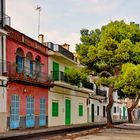Siesta
A siesta (Spanish pronunciation: [?sjesta]) (Spanish, meaning "nap") is a short nap taken in the early afternoon, often after the midday meal. Such a period of sleep is a common tradition in some countries, particularly those where the weather is warm.
The siesta is historically common throughout the Mediterranean and Southern Europe. It is the traditional daytime sleep of Spain and, through Spanish influence, the Philippines, and many Hispanic American countries. The word siesta of the Spanish language derives originally from the Latin word hora sexta "sixth hour" (counting from dawn, hence "midday rest"). Siesta is also common in Italy (there called riposo, pisolino), where museums, churches and shops close during midday so that proprietors can go home for a long lunch and perhaps a snooze during the day’s hottest hours. Einhard's Life of Charlemagne describes the emperor's summertime siestas: "In summer, after his midday meal, he would eat some fruit and take another drink; then he would remove his shoes and undress completely, just as he did at night, and rest for two or three hours."[1]
Factors explaining the geographical distribution of the modern siesta are high temperatures and heavy intake of food at the midday meal. Combined, these two factors contribute to the feeling of post-lunch drowsiness. In many countries that practice the siesta, the heat can be unbearable in the early afternoon, making a midday break at home welcome. However, siesta is also practiced in some colder regions, such as Patagonia. It used to be the custom in Russia, with Adam Olearius stating such was "the custom of the Countrey, where sleep is as necessary after Dinner as in the Night".[2] One source of hostility toward False Dmitriy I was that he did not "...indulge in the siesta."[3]:535 This may indicate that the siesta has a stronger relation with culture than with climate. (wikipedia)












Vitória Castelo Santos 29/07/2017 18:35
Ich mag Siesta:-))))))Ein tolles Foto
wünsche dir ein schönes Wochenende
LG Vitoria